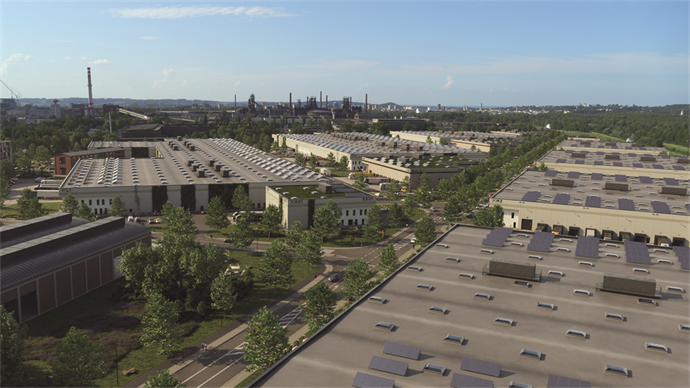P3 Logistic Parks believes more brownfield sites will aid the investor-developer to deliver returns and growth in key markets.
P3 Logistic Parks recently announced plans for its first brownfield development in Italy. The GIC-owned warehouse specialist said the San Pietro site in Casale in the Altedo district near the Bologna Interporto logistics hub would provide one or more turnkey warehouses of up to 100,000 m² when completed (pictured below).
In line with the company’s commitment to ESG best practice, a new layout is planned for the Altedo project, including initiatives such as cycle paths along with several other features which, when combined, should earn the overall project a ‘Green Logistics’ development certification.
Given the site is located on a former sugar factory, one could say that such a brownfield project is in the sweet spot for P3. As CEO Frank Pörschke explains, brownfield sites are set to play a larger and larger role in the overall activities of the firm. ‘Brownfield can contribute a higher proportion of development for P3,’ he says in an interview.
‘We cannot do everything on brownfield, but I would say comparatively speaking, the proportion of brownfield sites is increasing across the company.’
In the Altedo example, P3 Italia is ‘giving new life’ to a disused area. Andrea Amoretti, Italy MD, says: ‘We are creating jobs and improving at the same time the quality of life of the area through the construction of important infrastructure and environmental works.’
He adds: ‘It will be surrounded by greenery, served by public transport and cycle paths, and will have direct and fast access to the A13 motorway and the San Pietro in Casale railway station.’
News of P3’s first brownfield development in Italy will reignite the debate over greenfield versus brownfield development for logistics investors and developers in a market where land supply is tight. Cities are clamping down on land consumption of their green belt. Germany, which is P3’s largest market and where it has just over €2 bn of assets, is just one example. The country is railing against concerns of green land being gobbled up, setting itself a target of reducing land consumption from the current norm of 81 hectares a day to less than 30.
Pros and cons
Such push factors are inspiring companies such as P3 to commit to a path that will see brownfield sites playing a bigger role in its activities.
In October 2021, the firm revealed it had acquired a building on a 50,000 m² plot of land in Seclin, France, 6 km south of Lille. The site will house a 23,000 m² class A logistics asset on a former 50,000 m² industrial wasteland once an existing building is demolished. Here, the company is gunning for a BREEAM Very Good certification – work is due to start imminently.
P3 is under no illusions as to the complexity and costs of such projects when it comes to brownfield sites, yet it believes they are economically viable.
The Seclin project is P3’s first development in France. Up until now, it has only acquired properties, not developed them. But in this country, P3 is a signatory to the Afilog charter for the environmental performance of logistics buildings, underlining how the company is ‘committed to an approach that favours the conversion of industrial wasteland rather than the artificialisation of agricultural land’.
Acquiring and obtaining the necessary permission for the Lille project took a full two years, during which time numerous investigations and verifications were needed in this French region with a long industrial past.
Christophe Chauvard, MD of France, says: ‘Yes, it is a time-consuming commitment that requires numerous and sometimes complex procedures. It is necessary to carry out all the technical investigations required to ensure the compatibility of the project with its environment, and the various administrative procedures to close the previous industrial activity. But this development is nonetheless extremely positive and should, in the interest of all, benefit from major simplifications in the years to come. It’s a doubly virtuous approach, where we act to clean up former industrial sites while preserving arable land.’
He adds: ‘It is very likely that this site will be one of the last projects so close to the centre of Lille.’
Industrial heritage
Meanwhile, in the Czech Republic the company is undertaking a renovation of a 44-hectare brownfield site – not for the faint of heart. The 156,578 m² Ostrava Central park project will be rated BREEAM Excellent when completed. It will comprise of various units from 1,500 m² in size upwards. Construction begins in Q2 this year.
This brownfield development is bringing life back to the former iron ore industrial site in what ranks as the Czech Republic’s second- largest urban area after Prague.
Ostrava has an historical industrial heritage going back to the 13th century. In more modern times, raw materials were stored here. Iron ore was prepared for the blast furnaces of the Vitkovice Ironworks, but this place sank into oblivion. In its last year – 1994 – coal was mined in the area.
Nowadays, the wider Ostrava region still has a deep labour pool and serves as a base for automotive logistics such as the Hyundai plant in Nosovice and Kia’s facility in Zilina.
For Ostrava Central, P3 has employed the services of award-winning architect David Kotek to connect its new industrial zone with the nearby town centre with plenty of new green space (130,000 m² no less!).
P3’s Pörschke explains that the firm tends to think of all sites with a previous use as being ‘brownfield’ (other than former agricultural use). These sites can range from ghost shopping malls and disused railway buildings to former military barracks. However, practically speaking the readily available sites P3 is looking at tend to have an industrial history to them.
There is a ‘societal’ benefit in not using green land, he notes. Cities are pushing for brownfield development rather than green land consumption. At the same time, clients want brownfield sites within city and city-fringe locations for e-commerce uses.
‘In order to fulfil this demand, we are searching for land. We observe it is getting more and more difficult to find green land. This is why we are including brownfield in our focus.’
‘Brownfield is more complex to develop at least in practical terms and being more central may even be more sensitive to the cities than greenfield. That said, contamination is an issue and dealing with it is better than leaving contamination there.’
Of course, someone has to pay for the higher costs associated with brownfield sites, but so long as the business case is there, Pörschke believes customers are prepared to pay a level of rent that makes sense for all parties.
Speaking of the entire European logistics and warehousing landscape, he says rents have gone up to a certain extent and he expects them to go up more.
A negative factor is increasing land costs. These are necessarily leading to certain rent assumptions. But then again, valuations of logistics real estate have been going up. Notes Pörschke: ‘To a certain extent yield compression has helped. As the value of what we have goes up, we can afford slightly higher costs. We expect yield compression will come to an end later this year or latest in 2023 with interest rate levels rising. But we do expect rent levels to go up because of demand.’
P3 is currently invested in 11 countries, and has operations in nine of those. Germany is its single largest market where it has just over €2 bn of assets. The company is 100% owned by Singapore sovereign wealth fund, GIC.



































